Ancient Egyptians worshiped many gods. Their gods looked over them in their everyday life. Some gods controlled the sun, and others controlled the weather and crops. The Egyptians worshiped their gods by building altars and idols for their gods. They made sacrifices to their gods in order to appease them and prompt them to bring good weather and crops. The Egyptians also prayed to their gods for their help in conflicts.
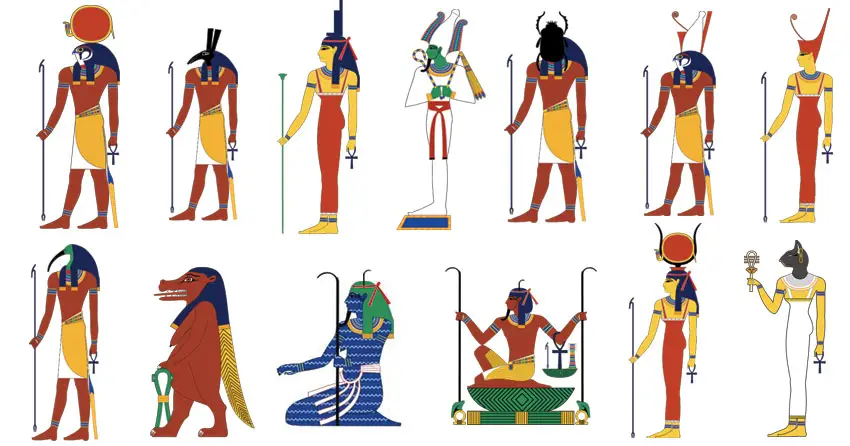
The first Egyptian gods were a group of eight primordial deities. They were born from the void of Chaos, the gap between Heaven and Earth. These eight gods formed the Ogdoad. The following eight gods make up the Ogdoad.
1. Nu or Nun
Father of the Gods
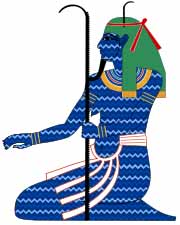
Nu, or the feminine Naunet, was one of the first Egyptian gods. He is often depicted with a beard and blue or green skin. He is also depicted with a frog’s head. His female aspect, Naunet, is often depicted as a woman with a snake’s head. By portraying Nu as blue or green, Egyptians were referencing the Nun, the motionless body of water that held the universe. Nu is the father of Re, the sun god. Nu is associated with chaos, water, the Nile, and fertility. He is believed to be behind the yearly flooding of the Nile.
2. Amun
Symbol of Air and the Sun
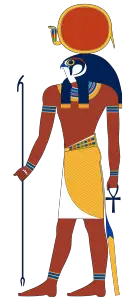
Amun was the husband of Amaunet. His name means the hidden one. He started out as a minor god, but by the 16th century BC, he had become the patron deity of Thebes, which was the royal capital. He championed the less fortunate and protected the poor. He was also known as a protector of the road. He was originally depicted as a bearded man with a double plume. Later, he had a ram’s head, which symbolized fertility. The Egyptians believed he was the Creator God who had populated the world by mating with himself.
Later, he was linked to the god Ra, so he became Amun Ra, a sun god. He also was a fertility and war god. Because he was linked to Ra and he was also the hidden one, Amun became more of an unseen deity who was everywhere at once. Amun was worshiped throughout Egypt, and his popularity eclipsed that of other gods. He was worshiped until Christianity took hold.
3. Amaunet
Symbol of Female Hidden One
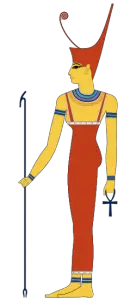
Amaunet was the wife of Amun. She was considered the protector of the Pharoah. Amaunet was depicted with a snake’s head. She has also been depicted with wings and with a sign of the west on her head. She was known as the goddess of invisibility and the air. Amaunet was also believed to be the goddess who welcomed people to the afterworld. She was believed to be the mother of all creation associated with the acacia tree where all the gods were born.
4. Heh
Symbol of infinity and eternity
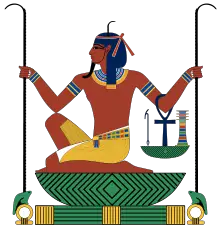
Heh means flood, which was associated with the watery depths from which the gods emerged. This watery depth was infinite, and Heh was associated with the primordial waters. He had a frog’s head, which symbolized fertility and creation. He was also depicted crouching, holding a palm frond in each head. Palm’s represented a long life. There were shen rings at the base of the palms, and they represented infinity.
Heh’s hieroglyph represents the number one million, which Egyptians associated with infinity. Heh was depicted wearing a scarab on King Tutankhamun’s tomb. This representation means that King Tutankhamun was granted millions of years into the afterlife.
Heh also represented air and was believed to be linked to the four pillars holding the sky. He is associated with Hauhet.
5. Hauhet
Symbol of space, eternity, and infinity
Hauhet was the wife of Heh. Her name also represented the primordial waters. She represented a perceptive mind and intelligence. Her existence is abstract, and sometimes she is just considered a half of Heh. However, she supposedly helped produce the cosmic egg, where all life was created.
6. Kek and Kaukek
Symbol of light and the night
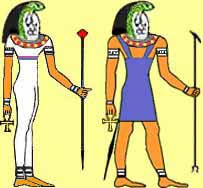
Kek and the feminine Kaukek represented the primordial darkness where they were first formed. They represented night and day. Kek had a frog’s head with a beetle on the top, and Kaukek had a serpent’s head with a disk on top. Kek was the bringer of the light, so he was the god of twilight just before dawn. Kaukek was the bringer of the night, so she was the goddess of twilight just after sunset. Ancient Egyptians believed that Kek and Kaukek would bring the primordial darkness to the world once more.
Those were the eight gods from the Ogdoad. The following are other important Egyptian gods.
7. Ra
Symbol of light
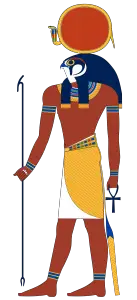
Ra was one of the most important gods in the Egyptian religion. He represented the noon sun, which was important for life and growth. Ra was believed to rule the sky, underworld, and earth. He travelled the sky and the underworld by boat. These travels created night and day. He was usually depicted with a falcon head and a sun disk.
Ra created all forms of life. He called them into existence by speaking their secret names. The man was created from Ra’s tears and sweat. Ra is the father of the wind god Shu and the rain goddess Tefnut. Ra is believed to have created the seasons, animals, plants, and months.
8. Osiris
Symbol of the afterworld and rebirth
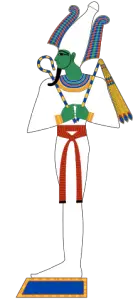
Osiris is the god of the underworld. He is also associated with the Nile and vegetation. He is married to Isis and is the father of the god Horus. He is depicted with green skin, wrapped legs like a mummy, a pharaoh’s beard and a white feathered crown. He was the judge of the dead and the underworld.
There is an Egyptian myth involving Osiris. Osiris’s brother Set murdered him to gain the throne. When Isis found Osiris’s body, she hid it in the reeds by the Nile. Set found the body and dismembered it. Isis found all the parts and put them back together. She used magic to revive Osiris briefly enough for him to impregnate her. Isis then embalmed Osiris and entombed him. Her son, Horus, grew up and took back his father’s throne.
9. Bastet
Symbol of war and protection
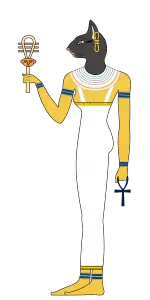
Bastet was the goddess of warfare. She was originally a fierce lioness and warrior goddess. Later, she was depicted as a cat. Cats were revered in Egypt because they kept mice and snakes away from food and people. Bastet was considered a defender of the Pharaoh and Ra. At times, she embodies the Eye of Ra and goes after his enemies, including Apep, the evil snake that chases Ra around the world.
Bastet was also the goddess of the home and represented women’s secrets, domesticity, and fertility. She protected the home from disease and evil spirits. She is also a guide for the dead in the afterlife.
10. Hathor
Symbol of motherhood, love, music, beauty, and dance
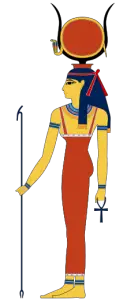
Hathor played a variety of roles in Ancient Egypt. She was a sky deity and a consort to Ra and Horus. She was considered the mother of the Pharaohs. She also acted as the Eye of Ra and protected him from his enemies. At one point, when she was acting as the eye of Ra, she threatened to destroy man, but she was pacified with red-tinted beer that she believed was the blood of mankind. She demonstrated the concept of Egyptian femininity by showing both a vengeful side and a benevolent side. She was a consort to many gods. Hathor also helped souls in the afterlife.
Hathor was depicted with a cow headdress and a sun. She was also depicted as a cow. These showed her celestial and maternal aspects. She gave birth to the sun god each dawn.
11. Horus
Symbol of the sky, moon, and sun
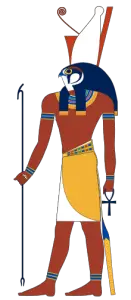
Horus was the son of Isis and Osiris. He is the god of the sky and is depicted as having a falcon’s head. The moon and the sun represent his eyes as he flies through the sky. Horus is associated with the pharaohs because of his lineage story. The Eye of Horus is a symbol of protection among the pharaohs.
Horus and Set fought constantly for the throne. They finally decided to have a boat race to determine who would have the throne. Set had a stone boat, but Horus had a wooden boat that looked like stone. Set’s boat sank, and Horus won the race and the throne of Egypt.
12. Set
Symbol of violence, disorder, infertility
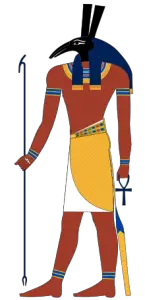
Set is the god of the desert, violence, and storms, and foreigners. Set is usually depicted with the head of a fantastical beast called a Set animal. It sometimes looks like a stylized giraffe or a composite animal.
Set killed his brother to take over the throne of Egypt. Horus fought Set and won the throne back. After abdicating the throne, Set became the god of the desert and helped Ra defeat the serpent Apep. Set was the god of the desert, and Horus was the god of the soil.
13. Thoth
A Symbol of animals, equilibrium, writing, and the moon
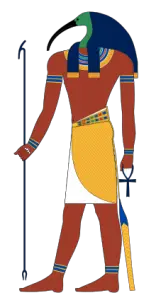
Thoth was the Ibis god. He was depicted with the head of an Ibis and his name translates to Ibis. As the ibis, he controls time and the seasons. He is also depicted as having the head of a baboon. This represents equilibrium.
Thoth took on the role of mediator between good and evil. He made sure judgments were balanced so neither good nor evil prevailed. He was also the god of writing and was credited for inventing hieroglyphics. In the underworld, he oversaw the scales of balance. He created the earth, stars, and heaven and his feminine counterpart maintained the balance of the universe.
During epic battles between gods, Thoth would heal them if they suffered a bad wound so neither side would be victorious and balance would remain in the world. Thoth also gave Isis the magic words to bring Osiris back to life, briefly.
Thoth was the god of the moon, wisdom, and magic. The moon’s light helped shape the calendar and days. Thoth was Ra’s secretary. He was the scribe of the gods.
14. Khepri
Symbol of renewal of life and creation
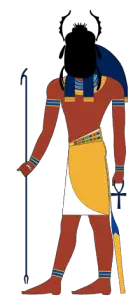
Khepri represents the morning sun and the creation of the world. He is depicted with a scarab beetle’s head. Egyptians observed the scarab beetle rolling its dung in a ball along the ground. They associated that with the movement of the sun in the sky. The scarab beetle’s eggs were in the ball of dung, and when they hatched fully formed, the Egyptians thought their birth was a magical creation.
Khepri was considered a subordinate of Ra, as Ra was the god of the midday sun. Scarab amulets and jewelry are associated with Khepri.
15. Taweret
Symbol of fertility and childbirth
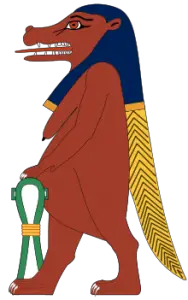
Taweret is the protective goddess of fertility and childbirth. She is often depicted as a hippopotamus standing on two legs. Female hippopotamuses were revered in Ancient Egypt because they were fearsomely protective of their young. Taweret is a protective household goddess.
Taweret was featured more in Middle Egypt on knives made from the tusks of the hippopotamus and child’s cups. She was also a goddess of funeral rites. This was probably an association of rebirth after death. She was associated with the rejuvenation of the dead and cleansed the bodies of the dead so they could go into the afterlife. Because she did this, she was called the mistress of pure water.
